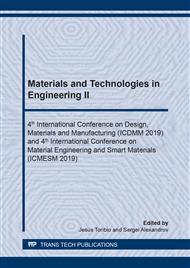p.18
p.24
p.33
p.41
p.50
p.55
p.61
p.71
p.78
Color Intensity of Architectural Concrete Depending on the Type of Cement
Abstract:
In this paper, the influence of the cement type on the final coloring of the concrete with colored powdered inorganic pigments used currently with increasing tendency in construction and modern architecture is presented. In the experimental testing, the difference in intensity/saturation of the color of the concrete containing white cement (CEM I 52.5 R - SR 5 white), which is preferred when using color pigments, and gray (conventional) Portland cement (CEM I 52.5 R) from the same manufacturer has been measured and compared. Three colored inorganic powder pigments (red, green and yellow pigment) containing iron oxides (Fe2O3) have been used to color the concrete mixture. Objectivity of measurement, comparison, and subsequent analysis of individual resulting shades has been ensured by measuring exact RGB values at several places of the concrete cured surface by means of the Colorimeter Colorcatch nanodevice which automatically eliminates all irrelevant color shades, shadows, and impurities. This eliminated the subjective color impression which is usually always biased by external circumstances. Comparison of the color intensity of six experimental samples, including three pigment colors and two types of cement (white/grey), is conclusively related to the color efficiency ratio, the resulting costs, and the ecological footprint arising from the production of the cements above.
Info:
Periodical:
Pages:
50-54
Citation:
Online since:
April 2020
Authors:
Keywords:
Price:
Сopyright:
© 2020 Trans Tech Publications Ltd. All Rights Reserved
Share:
Citation:


